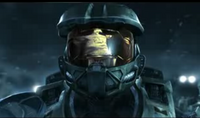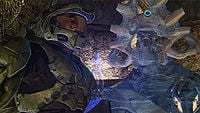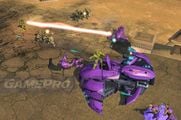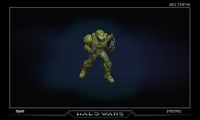SPARTAN-II program
From Halopedia, the Halo wiki
Template:Infobox Military Unit
- "You have been called upon to serve, you will be trained...and you will become the best we can make of you. You will be the Protectors of Earth and all her Colonies"
- — Dr. Halsey to SPARTAN recruits
The SPARTAN-II Program was part of the SPARTAN Program, an effort to produce elite soldiers through biological, mechanical and genetic augmentation. The SPARTAN-II program would be the first in the series to meld advanced mechanical technology with the troopers' superior physiques. It is widely considered that out of the three Spartan variants, the Spartan-IIs are the best.
History
Origins
Projections calculated by the UNSC Office of Naval Intelligence concluded that by 2525 the instability of the outer colonies would result in widespread rebellions unless drastic military measures were taken. The SPARTAN-II program would meet these requirements, creating a small group of elite soldiers meant to subdue insurrections in their infancy. In this way, civilian casualties might be minimized, civil war averted, and costly conventional solutions made unnecessary.
The project was led by Dr Catherine Halsey of ONI's Section 3 and Chief Petty Officer Mendez of the UNSC armed forces. Candidates for the program were selected from children deemed to possess superior physical and mental attributes. By 2517, 150 suitable candidates had been identified, but for budget reasons only half that number were "conscripted", most were between five and seven years old. To preserve the program's secrecy, the children were replaced by flash clones which would die soon thereafter due to numerous medical complications associated with flash-cloning an entire human being.
Taken to Reach, these child-soldiers began training under CPO Mendez. To marginalize the civilian lives they had once led, their names became a combination of their given names and a number (like "John-117"), with family names being discarded. Seven years later they began receiving the physical augmentations that would ultimately make them Spartans. The procedures were risky and nearly half died as a result. A small number survived, of which some were physically crippled (such as SPARTAN-084); these were discharged from the program and placed in non-combat positions where their enhanced mental faculties might still prove useful. Only 33 survived without complications and, now much improved, remained fit for combat duty. Those who died were cremated and buried in space.
The year 2525 would see the fulfillment of the program when the survivors were fitted with the MJOLNIR Mark IV Powered Assault Armour.
The Human-Covenant War
The conflict with the Covenant marked a change in the objectives of the program. Originally intended to quell rebellions, the Spartans were now forced into battle against an opponent much superior to the UNSC. Although on an individual basis, the Spartans were to frequently demonstrate their superiority over the enemy, the scope of their stunning successes were only tactical in nature. Nonetheless, heroic rearguard and delaying actions saved countless human lives from the genocidal Covenant campaign. During the Covenant campaign, it was decided to make the Spartan-II project public, in an effort to boost morale.
Inevitably the small number of SPARTAN-IIs dwindled as casualties were sustained. As the exploits of the Spartans was a major propaganda boon to the UNSC, Section Two of ONI issued Directive 930 stating that Spartans killed or crippled would be listed as "missing in action" or "wounded in action", thus maintaining the illusion of Spartan invincibility.
In late 2552, all except three of the remaining Spartans rendezvoused at Reach to receive new orders for an operation that HIGHCOM hoped would end the war. They would commandeer a Covenant vessel, locate the Covenant homeworld, and return with captured Covenant leadership. To this end the Spartans were slated to be re-equipped with MJOLNIR Mark V suits. The A.I. Cortana, carried within John-117's armor, would serve as the strike force's hacker and technology specialist.
However, all preparations were interrupted (and subsequently canceled) by the Covenant assault on Reach. In the ensuing disaster most of the SPARTAN-IIs were killed. Two escaped (one was technically dead but later revived), aboard the UNSC Pillar of Autumn, while the rest remained trapped on Reach.
Following the events at Alpha Halo, the Spartans were reunited at Reach. They then carried out a strike that resulted in the destruction of a Covenant fleet anchorage which contributed to the UNSC victory at the First Battle of Earth. SPARTAN-IIs would go on to play pivotal roles at the Battle of Onyx and the Second Battle of Earth.
Technology
Biological Augmentation
- Main article: SPARTAN-II Augmentation Procedures
Admiral Ysionris Jeromi of the research station Hopeful documented the following experimental procedures on Bonobo Chimpanzees. These operations were later performed on the Spartan soldiers:
- Carbide ceramic ossification: The grafting of advanced materials onto the skeletal structure to make bones almost unbreakable. If coverage exceeded 3 percent of the total bone, mass white blood cell necrosis was common. In adolescents, growth spurts could result in bone pulverization.
- Muscular enhancement injections: An intra-muscular injection of a protein complex to increase tissue density and decrease lactose recovery time. Increased the risk of a fatal cardiac volume increase.
- Catalytic thyroid implant: The implantation of a platinum pellet in the thyroid containing human growth hormone catalyst. This boosted growth of skeletal and muscle tissues. It was known to suppress the sexual drive and cause elephantiasis.
- Occipital capillary reversal: Increased blood vessel flow beneath the rods and cones of the retina. Increases visual perception. Known to cause retina rejection and detachment, as well as permanent blindness.
- Superconducting fabrication of neural dendrites: Altered the bio-electrical nerve trans-duction to shielded electronic trans-duction. Resulted in a 300 percent increase in reflexes. Showed evidence of an increase in intelligence, memory, and creativity. Often caused Parkinson's disease and Fletcher's syndrome.
The results of these experiments were used by the SPARTAN-III program designers to refine their bio-augmentation procedures.
MJOLNIR Armor

The SPARTAN-II program was conceived in parallel with the development of the MJOLNIR armor (Pronounced: My-ol'-nir). The Spartans received the first practical forms of the armor, the Mark IV, in 2525, followed by the Mark V and Mark VI in 2552.
The demands of the armor were such that only the Spartans could wear them. A number of unaugmented Humans were killed attempting to use the suit during test trials because of the power the suit translated from normal movements. Project MJOLNIR's main rival in the race to create an armor for the SPARTAN-II Program was Project HAYABUSA, the Japanese equivalent to Dr. Catherine Halsey and Project MJOLNIR.
Background
Surviving SPARTAN-IIs
- ""Die? Didn't you hear... Spartans never die.""
- — Kurt-051 upon his death.
The identities of the Spartans' full names have been deleted from the military records. Only their tags are known with their current status.
Beginning of SPARTAN-II ("First" Spartans) originally selected 150 potential candidates, however there was only funding for half that number, so the Spartan candidates were further scrutinized, producing 75 "test subjects".
SPARTAN-II ("Second" Spartans) were not "allowed" to be marked as KIA as it was thought that the idea that SPARTANs were dying would be a crushing blow to morale of the UNSC soldiers. This gave rise to the idea that SPARTANs could not die.
- "No Spartan could be listed KIA, only MIA or WIA. This is so it could be said that no Spartan could ever be killed in combat."
- — Lt Niraj Shah; UNSC (retired; active duty: 2548-2573)
Spartans are only recorded as MIA, even if there are eyewitnesses to their deaths. This maintains the morale of UNSC soldiers and the rumor that Spartans never die.
Class I
Class II
Some Spartans were drafted or conscripted into the Spartan program after the original IIs graduated.[1] The only known Spartans from this second class are:
- Yasmine - Died from complications in Augmentation
- Nicole-458 - Trapped in the 21st Century (presumed non-canon)
SPARTAN-IIs Conscripted
There is some confusion concerning the number of SPARTAN-IIs throughout the series. For example In Halo: The Fall of Reach, it is cited on page 46 that there are 75 children on board a pelican for a training mission, however on page 47 it states that there were 67 children on the training mission out of 75 that were originally on board. No mention is made of the whereabouts of the missing 8. After the augmentation process all 75 reappear, with 33 successfully surviving, 12 surviving but were crippled, and 30 being killed as a result of the procedures.
The status of SPARTAN-IIs is muddied further in the later novels. For example, Kurt-051 is listed as missing in action presumed dead in 2531 when in reality he was drafted into the SPARTAN-III Program until his real death in 2552 on Onyx. Three Spartans, designated Gray Team, were said to have been on "fields of battle too distant to be easily recalled" prior to the Battle of Reach[2]. In Halo: Ghosts of Onyx these three were said not to have been heard from for a year. The book, "Halo: The Cole Protocol" features Gray Team as major characters, but did not explain why they had not been heard from. It is also stated in Fall of Reach that there are 30 Spartans present during the Battle of Reach,[3] and in Halo: First Strike is states that there are 27 Spartans present on the ground (3 taking the space mission),[4] but only 25 Spartans could have been present.[5]
Bungie along with Eric S. Trautmann have said that these discrepancies only seem to be errors and that everything will be made clear in time.
Trivia
- The Marines refer to all Navy personnel as Swabbie, including Spartans (though it has only been observed with John-117).
- The Spartans are based on the ancient Greeks from Sparta, known for their military might and extreme training regiments and were, at the time, the greatest infantry fighting force in the world. Similarly, it is also reminiscent of the Turkish Jannisary Corps, where sons of Christian families were taken and trained under strict discipline and in practically monastic conditions, to become the elite fighting force of the Ottoman Empire.
- In Sparta, to become a warrior the child had to have no mental disability and could not be crippled. Training also began at an early age, usually at the age of 7. This is much like the SPARTAN-II's augmentations and training.
- The SPARTAN-II Program was incorrectly referred to as the first super soldiers ever made by humanity on the back cover of Halo: The Fall of Reach.
- In campaign gameplay, John-117 is the only Spartan that you can control and you can see. The games refer to him as the last surviving or, in Halo 3, active Spartan, contradicting other sources.
- The Halo 3 Achievements "UNSC Spartan" and "Spartan Officer" both show the official Spartan-II seal.
- The only Spartan II that was listed as KIA was John-117.
Gallery
- Fall of Reach.jpg
Four SPARTAN-II Soldiers in 2552
- GoO-SPARTANs.jpg
References
| |||||||||||||||||
| ||||||||


